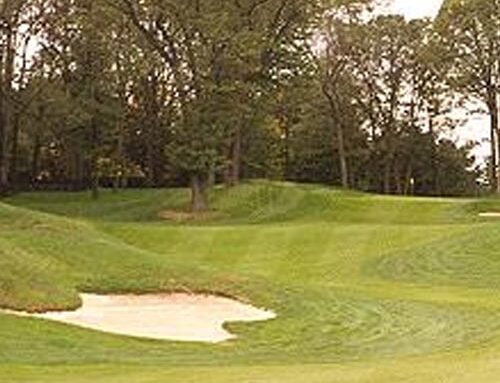Banff Springs Golf Course
Alberta, Canada

Though golf course critics differ as to what makes a course great, the one attribute that they agree upon is that a great course must possess great holes. And as seen above at the one shot fourth…
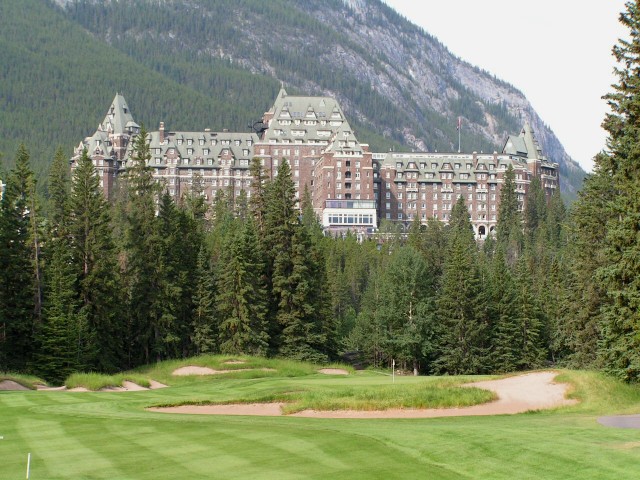
…and the approach to the fourteenth, Banff’s best compete with any course in the world.
When Jasper Park opened in 1926, the bar in Canadian golf course architecture was forever raised. Though some excellent designs existed prior to then, namely Harry Colt’s work at Hamilton Golf & Country Club and Toronto Golf Club (where Thompson caddied as a youth), Stanley Thompson’s ability to build a course in the wilder environs of Canada was a breakthrough moment.
One of the keys at Jasper for Thompson was the fact that the Canadian National Railroad was his customer and therefore, hauling in train loads of top soil to spread over the rocky soil became possible. Though Jasper Park cost $880,000, the Canadian National Railroad got a course that was the envy of all. World travelers and some of CNR’s best customers were anxious to play it as well as summer at Jasper.
A four hour drive south, the Canadian Pacific Railroad was green with jealousy. Their train route hugged the Bow River and they too were keen to have a world class course. Though golf had been played at Banff since 1911 when the Scot Bill Thompson laid out a nine hole course,CPR had since realized the course wasn’t in keeping with grandeur of the Banff Springs Hotel, soon to become known world wide as the Castle in the Rockies. CPR hired Donald Ross to improve and expand upon the course. His 18 hole course won praise at the time but upon seeing the completion of Jasper Park, there wasno doubt as to which was the pick of the two.
Thus, in 1927, CPR hired Thompson to build them a ‘championship’ course; one that they hoped would be a better draw than the Jasper Park course. Thompson spent several weeks stomping around the grounds and decided that the course should go further toward the Banff Springs Hotel than the Ross routing which stopped at today’s 12th green.Permission was gained to use the property where today’s 13th, 14th, 15th, and 16th holes now occupy. In addition, Thompson sought and got the use of the land that would become today’s third, fourth and fifth holes.
When done, the only green site that Thompson would keep from the Ross course was that of today’s second hole. Again, the fact that his customer was a railroad was crucial as train loads upon train loads of top soil needed to be brought in from the plains east of the Canadian Rockies. Still, when Thompson’s 18 opened in 1929 at a cost of over $1,000,000, it was acknowledged as the most expensive course ever built at that time.
Studied separately, the groupings of the one, two and three shotters are of very high quality. Only today’s first hole is not included below, in part because the dogleg left Thompson tee was lost when the new clubhouse (meant to resemble an Indian tepee) was built in 1989 and in part because of the non-Thompson like mounds added by Bill Robinson down the left when the third nine was added in 1989.
Holes to Note
Second hole, 180 yards, Rundle; Thompson liked to angle his greens, a trait that his pupil Robert Trent Jones Sr. (who worked on the crew here) later used as well.
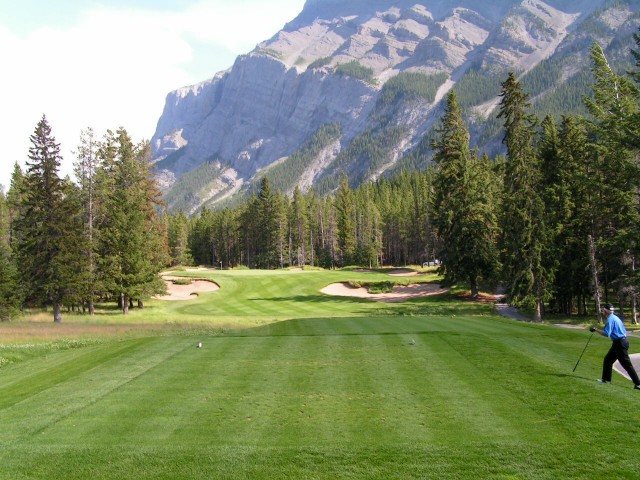
From an elevated tee to an elevated green, the attractively placed second green is angled from front right to back left.
Third hole, 535 yards, Gibraltar; Knowing the hole that comes next, some first time visitors take the 3rdfor granted. And given the thin mountain air, the tiger golfer may assume that a birdie is a foregone conclusion. However, ever the master of deception, all is not as simple as the golfer might hope. Firstly, the green is around the shoulder of the hill that protrudes from the right into play some sixty to eighty yards shy of the green. The tiger ideally needs to cut his ball to get home in two. At 60 paces long, the 3rd is second only to the 7th green (another three shotter) as the largest on the course. Though the golfer may be near the green in two, an up and down is not easy.With Mount Rundle rising up nearly one mile as a backdrop, the golfer is surprised to find a green that falls from front to back, i.e. toward the massive mountain. In a recent club professional event,the pin was cut in the back right hole location. With golfers trying to get close in two and often times missing the green to the right, birdies were scarce as an up and down was next to impossible to the right to left pitched green. For the day, the hole played 6.09.
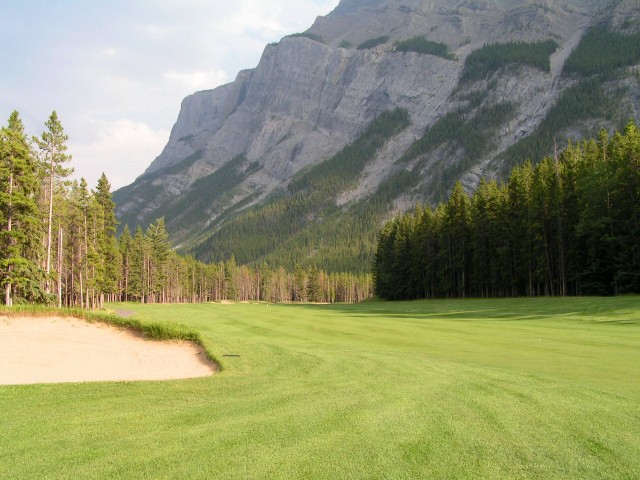
The long third fairway continues for another 310 yards and sweeps around the hillside to the right. One of Thompson’s great attributes as an architect was in making his holes appear as part of nature. In this case, he appreciated the value of hitting toward Mount Rundle and blasting was required to create room for this fairway. Unlike the work of many modern architects, the golfer has no idea that nature was ever disturbed.
Fourth hole, 200 yards, Devil’s Cauldron; During the course of the round, some may inadvertently start to take for granted Banff’s stunning beauty. Comparing it to other courses helps the golfer realize what just how one-of-a-kind, special Banff really is. Thus, think of your favorite one shot hole at your club, or perhaps your favorite one shotter in the state or province that you live. Then compare it to the one in the photograph below.
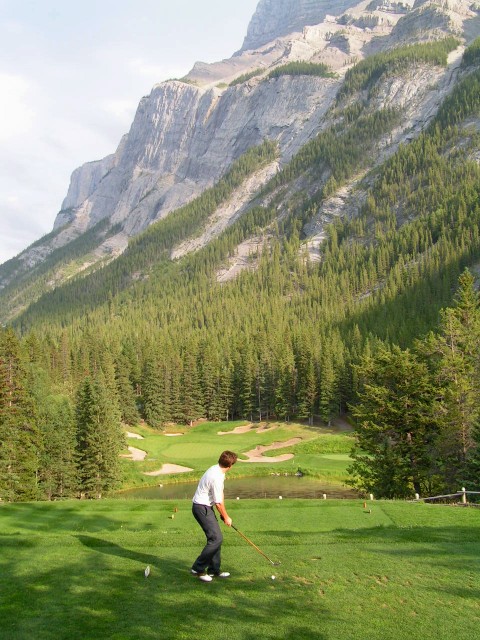
The golfer prepares to hit a Ben Sayer Redan Iron to the Cauldron green, a club consistent with those used during the course’s first decade of play.
The fourth green itself is of the punchbowl type and is steeply sloped from back to front to help get the water off it as fast as possible. The bunkers are a good six to ten paces off the putting surface and banks shots are possible on the tightly mown banks to work a ball toward certain back hole locations.
Fifth hole, 430 yards, Trough; Strategically as good as any hole at Banff, this dogleg left is well bunkered on the inside. As the green is again on a front right to back left angle to the player, the best play off the tee is toward the outside of the dogleg, exactly where Thompson placed another bunker.

This bunker dominates the inside of the dogleg left fifth hole.
Sixth hole, 380 yards, Fairholm; As Doug Wood highlighted during the 2004GolfClubAtlas annual gathering, this is an appealing transition hole. The golfer has played under the shadows of Mount Rundle for the past five holes and now emerges to see the widest fairway on the course with the distant mountain range a full twenty miles away. According to Wood, this is the only Ross green site that Thompson incorporated into his new design. The shoulders of the green are the high spots, so if the hole is left, the golfer needs to play right down the fairway and vice versa if the hole location is right. At3,200 square feet, this is the smallest green on the course. More bogeys are registered here than one might think based on the inviting view from the tee.
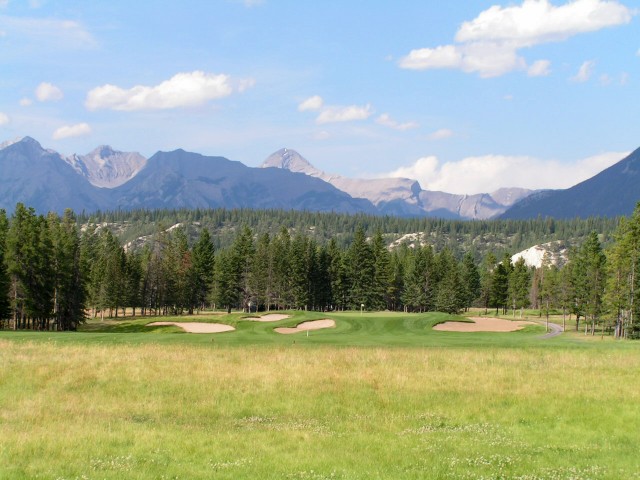
The golfer feels free to swing away from the sixth tee but thought needs to be given based on the day’s hole location.
Seventh hole, 610 yards, Hoodoo; The accepted definition of a classic three shotter is that each shot grows more exacting and few three shotters measure up to that standard as well as this one.Standing on the tee, there again appears miles of room but the player comes to appreciate that left is always preferred.The first true decision is how to handle the forty yard long Thompson bunker complex that starts 135 yards from the green and bites into the fairway from the right. Should he lay back short of it? Lay up beside it? Or perhaps for the strongest, even get past it? The author witnessed a good round come undone when a player put his second shot in it and three strikes later, the same player pitched out sideways rather than continue in vain to advance the ball near the green. The green itself rewards the golfer who has played aggressively for his two shots as it is long and narrow and best approached with a short club.
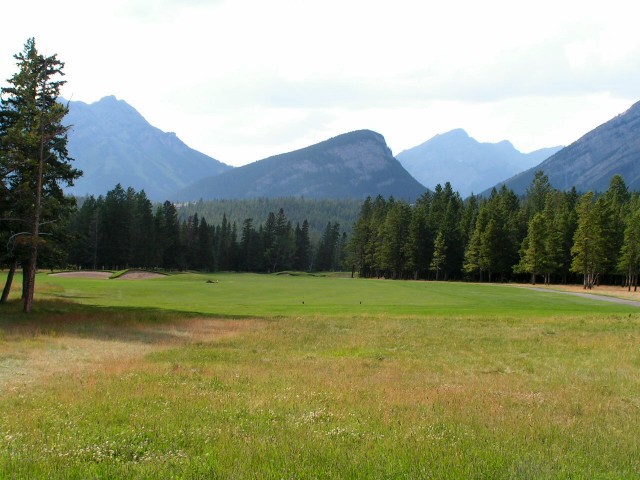
As seen from the tee, the seventh fairway seems wide but the trees on the right narrow the fairway corridor at the 340 yard mark from the tee and the shot requirements progressively tighten thereafter.
Eighth hole, 160 yards, Papoose; Thompson takes the player to the edge of the roaring Bow River and the next seven holes loosely track beside it as one returns in a southwesterly direction toward the Banff Springs Hotel. Formalizing the elbows of water that handle overflows from the Bow River gave Thompson the unique opportunity to have fronting water hazards; otherwise, the Bow just parallels the holes. With the right half bank of the green feeding into this water hazard and the hole set into the prevailing wind, the golfer best judge the wind correctly. Yet,especially with the high altitude and this being the first shot of the day in this direction, many a golfer has been fooled into mis-clubbing one way or another.

With water front right and bunkers around back, the eighth only remains the picture of tranquility once the golfer’s tee ball has found the putting surface.
Ninth hole, 510 yards, Jinx; Taken as a set, the greens at Banff lack some of the random interior contours found at Thompson’s other landmark works. Perhaps when Les Furber re-did the greens in 1998 some of the contours were softened to allow for today’s green speeds. Regardless, the ninth green is one of the best on the course. Severely tilted from left to right,it is full of character with much of its charm lying in the simplicity by which the architect followed the lay of the land (in this regard, one is reminded of some of the best greens at Garden City Golf Club). The first three shots on this hole are played entirely in hopes of getting the golfer the shortest distance underneath the hole as possible for an easy uphill putt.
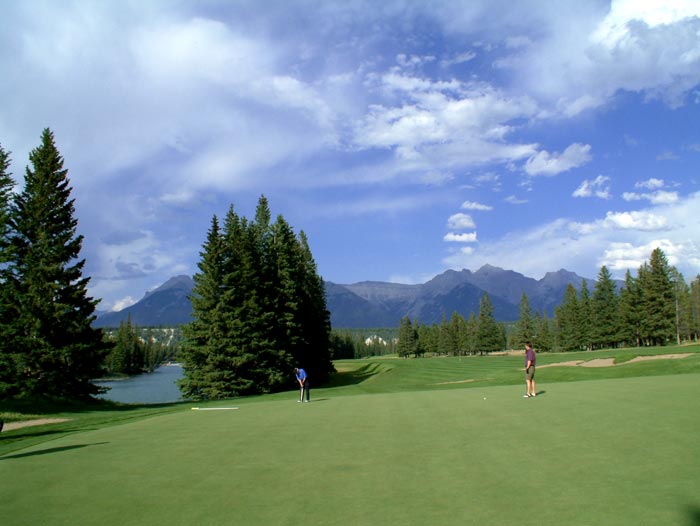
As seen from behind the ninth green, by looking at the relative position of the feet of the two golfers, one gains a sense of the green’s severe tilt.
Tenth hole, 225 yards, Little Bow; With the world famous Devil’s Cauldron soaking up so much attention, this one shotter doesn’t get near enough recognition. Often played into the prevailing wind, Thompson helps the golfer by building up a bunker ten yards left and short of the green, the grass back side of which was originally used to propel the ball onto the green. The green itself is one of the best on the course, featuring a spine running from five o’clock to 11 o’clock. Anything right of the spine feeds right and anything left feeds left. A well struck shot that catches the spine and feeds toward the back hole locations is a sight of beauty and one of true skill.
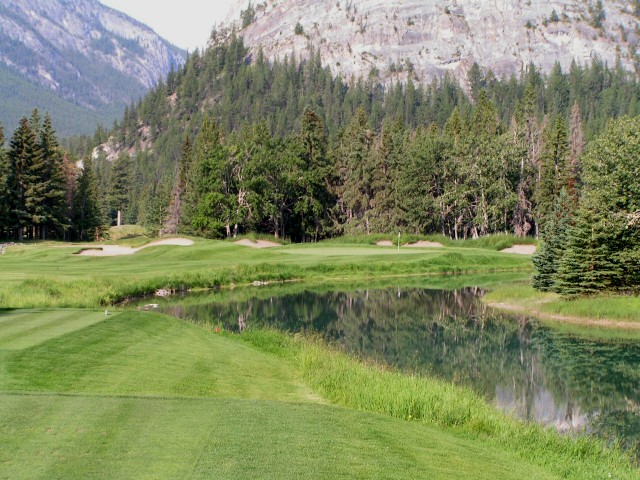
Which angle should the golfer take off the tenth tee – just right of the hole to leave himself an uphill birdie putt? Just left of the back bunker and let the spine feed the ball toward today’s hole location? Or perhaps…
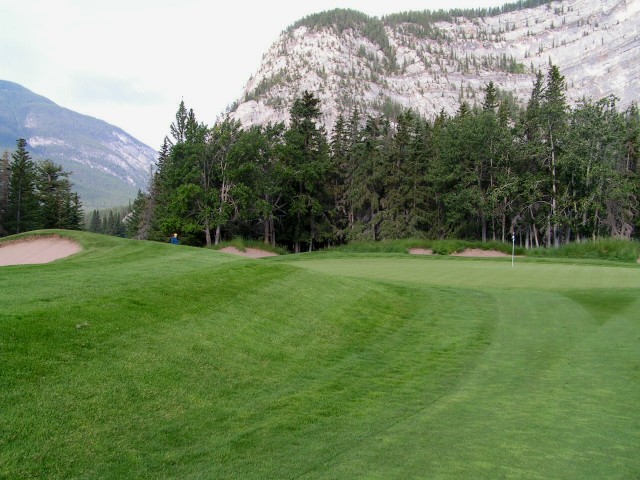
…play well away from the water and let this bunker slope kick the ball toward the green? The grass on the bank of the bunker needs to be cut tighter to propel the ball well onto the green as Thompson intended.
11th hole, 425 yards, Magpie; Thompson’s orders were to build a championship course at Banff and one of the areas this most manifests itself relative to his work at Jasper Park is that there are several green complexes here (namely the fourth, sixth, eighth, tenth, and eleventh) where a forced carry is really the only play. At Jasper, he did a magnificent job of always giving the weaker player some way of chasing a ball onto the green. Missing greens just short at Jasper often leaves the easiest up and down – not so at Banff where it takes some time to know where to best miss it.
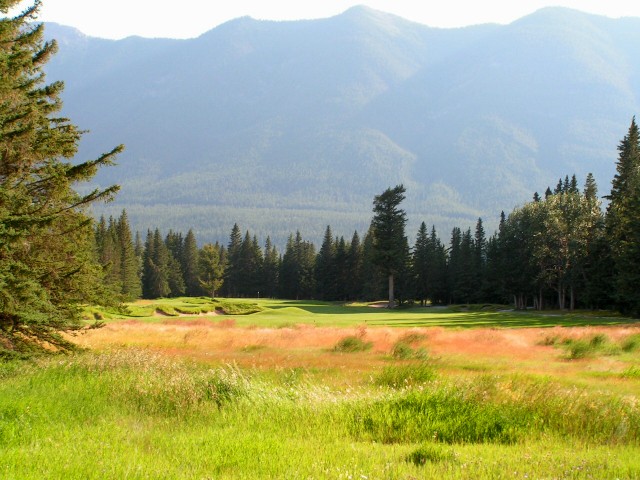
Banff has recaptured its rustic charm and texture by restoring the native grasses in recent years.
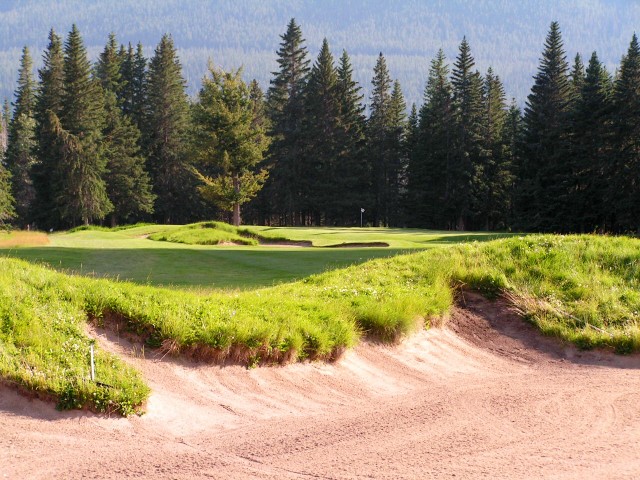
The golfer needs to avoid this bunker 260 yards off the 11th tee.
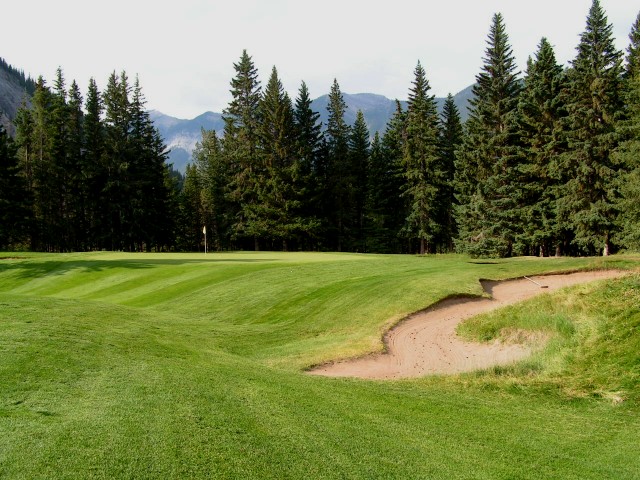
This depression before the eleventh green indicates that this is one of the holes were the approach needs to be carried all the way onto the putting surface.
Twelfth hole, 450 yards, Big Bow; One of the game’s great two shotters, the flag is visible from the tee and lures the golfer toward in that direction, i.e. the shortest route home. Any slight push on that line and the golfer will have tree trouble on his second. The green is angled to better receive shots from the left center of the fairway and with a deep bunker left and the Bow River right, requires the most exacting approach shot on the course.
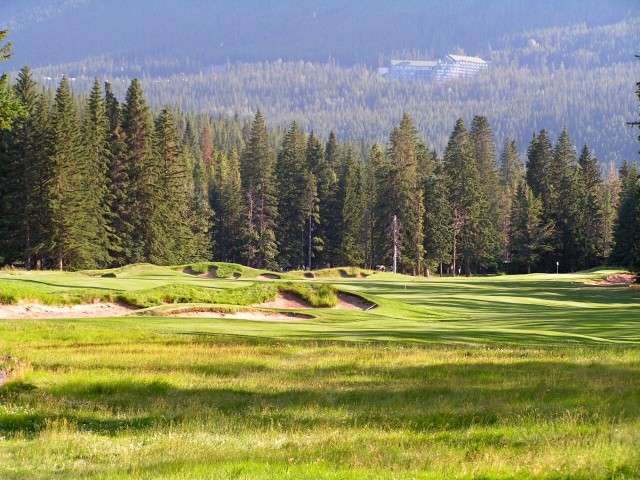
Thompson’s diagonal bunker that slashes into the fairway 180 yards from the tee breaks up the relatively flat landscape and helps lend the hole great visual interest. The bunker in the distance is 280 yards from the tee and the green opens up from near there.
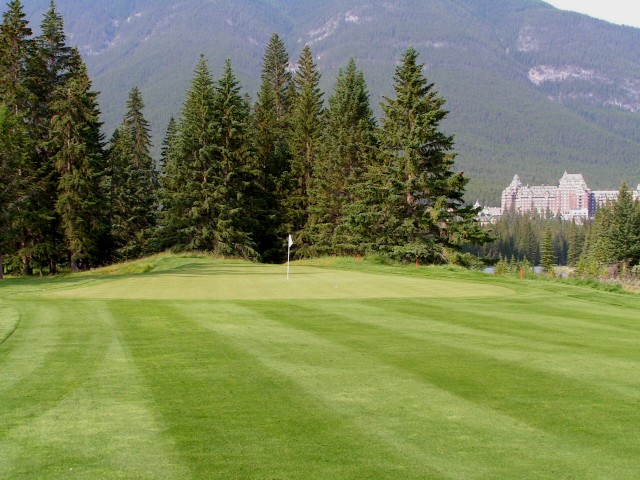
Common with several of the greens at Banff, the twelfth narrows as it goes back to the point where the green is a scant 11 paces wide at the back hole location.
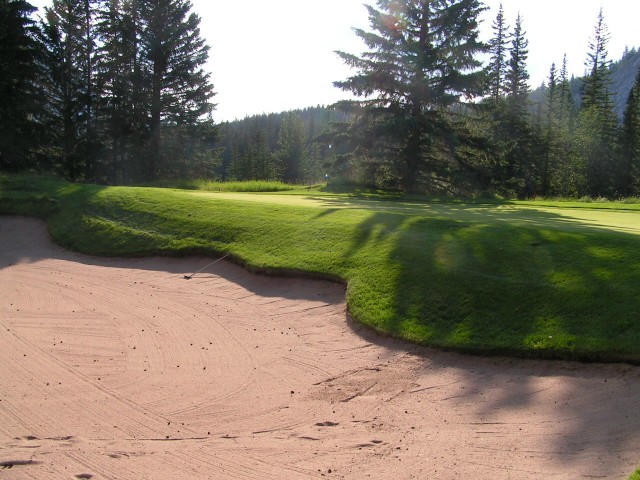
A recovery shot from the left greenside bunker is a ticklish one, as the green is narrow and the Bow River is right behind.
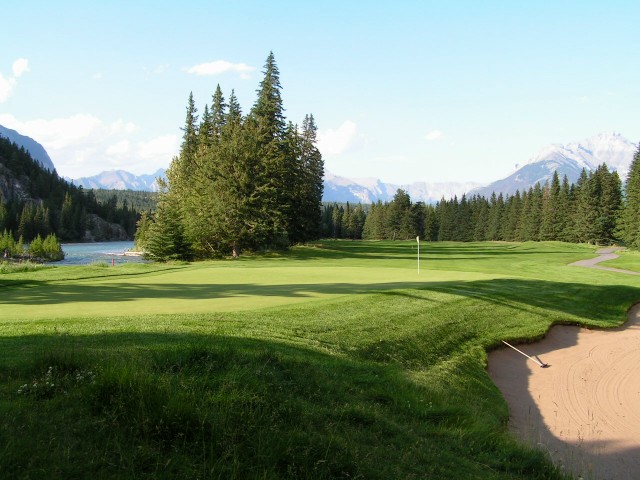
As seen from behind the twelfth, with the Bow River a few paces off the right of the green and the deep bunker left, only the truly brave – or foolish – do anything other than aim for the front middle of the green.
Thirteenth hole, 230 yards, Sulphur; Open in front and ringed on its sides and back by bunkers and mounds, this was the penultimate hole on Thompson’s design.Reflective ofhis marching from CPR, Thompson built a tough, hard golf course. The tiger golfer is always challenged and yet Thompson provides ways for the less accomplished player to enjoy his game as well. For example, this green is wide open in front and, like the twelfth, narrows in the back. The weaker golfer can certainly bumble one upnear the front edge while the tiger has more than his hands full to get near any of the middle or back hole locations.

Playing short to the thirteenth green is not a bad leave.
Fourteenth hole, 445 yards, Wampum; At one point, this hole had 28 of Banff’s 144 bunkers on it. During Les Furber’s 1998 bunker restoration,he moved Thompson’s manufactured bunker complex down the left of the fairway forty yards back and away from the tee. It now ends 260 yards from the tee and once again governs play. This is a fine example of what is meant by a sensitive restoration, whereby both the architect’s form and playing intent are returned to the course. Of note, the original fairway bunker complex was kept as a model and was destroyed only after everyone agreed that the newly created complex was a faithful replicate.
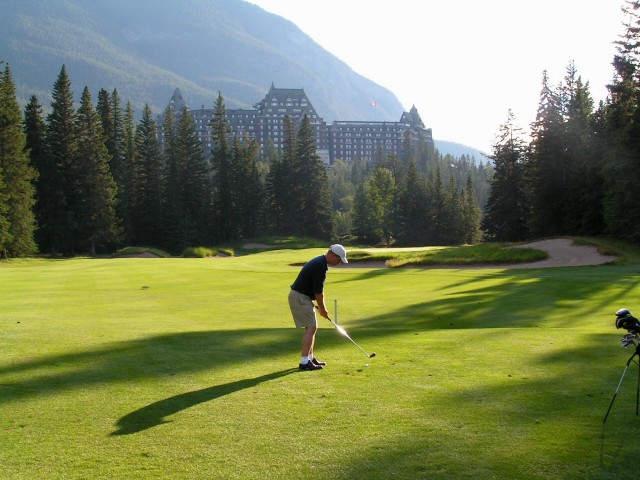
To have the good fortune to hit a solid approach to the fourteenth is a memory that stays with the golfer for a lifetime.
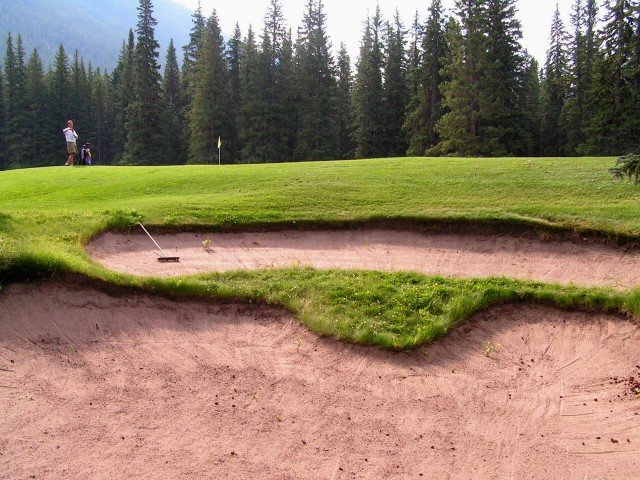
An approach pushed right at the fourteenth is rarely good…
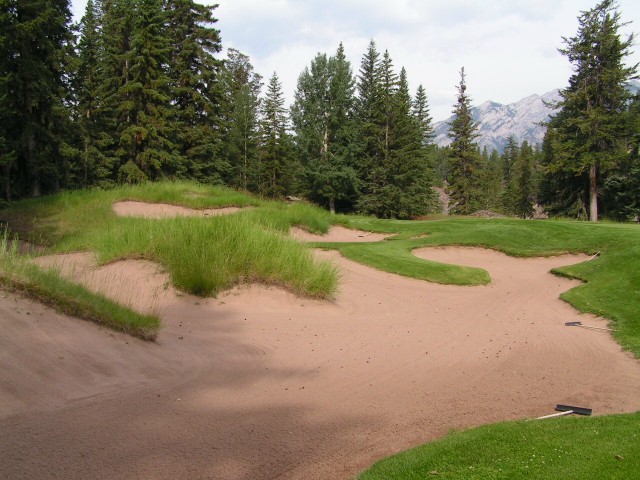
…and one pulled left will find one of the hole’s many bunkers.
Fifteenth hole, 480 yards, Spray; One benefit of the new sequence of holes is that the subject of golf’s greatest opening tee shot remains a lively debate. Otherwise, when this hole was the first, many a well traveled golfer would swear their allegiance to this being golf’s grandest opening shot.
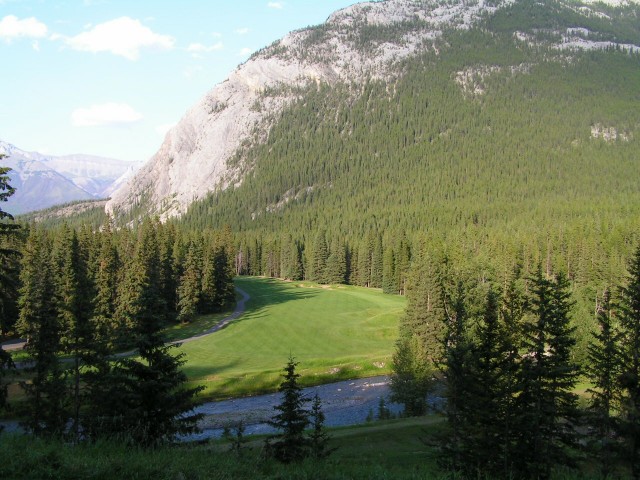
Thompson’s original championship tee was twenty yards below today’s tee and the white markers were some fifty yards lower and to the left. The thrill of watching a tee ball fall against Mount Rundle to the distant fairway below is something with which few courses can compete.
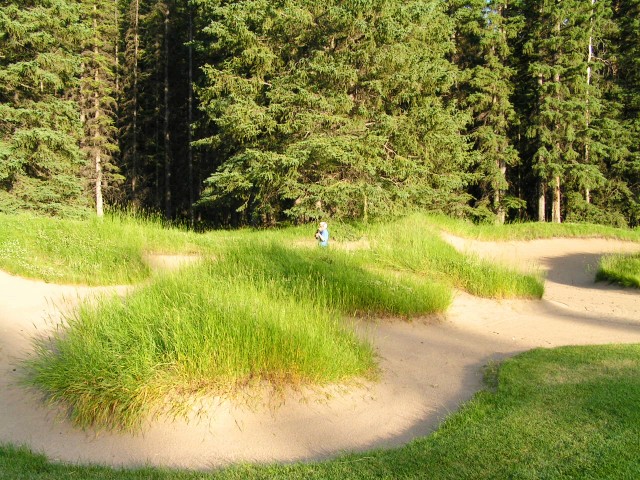
Save for perhaps Alister MacKenzie, has any architect ever matched Thompson for skill in constructing random bunkering, both in shape and placement? This one is sixty yards short and right of the 15th green.
Sixteenth hole, 420 yards, Goat; Set across flat, featureless terrain, Thompson needed to manufacture the interest and did so with a well bunkered switchback hole. In Thompson’s day when hickories dominated play, the golfer ideally drew his tee ball around the large left fairway bunker and faded his approach past the complex of bunkers along the right and front of the green. At the rate in which technology has changed in recent times, the tiger golfer is more apt to just power away with two straight balls today. Though some of the hole’s strategic merit has been lost with time, a recent round played at Banff by the author with hickories highlighted the merits of Thompson’s designs efforts at this hole. Ralph Livingston’s Feature Interview on this site is a tremendous resource in understanding how the game was played when Thompson was designing Banff.
Seventeenth hole, 385 yards, Sarcee; A favorite hole of Doug Wood for its subtlety, Thompson built the largest bunkers down the left of the fairway to suggest to the golfer to go right. In fact, the further right one drives, the progressively worse the angle of attack into the green.
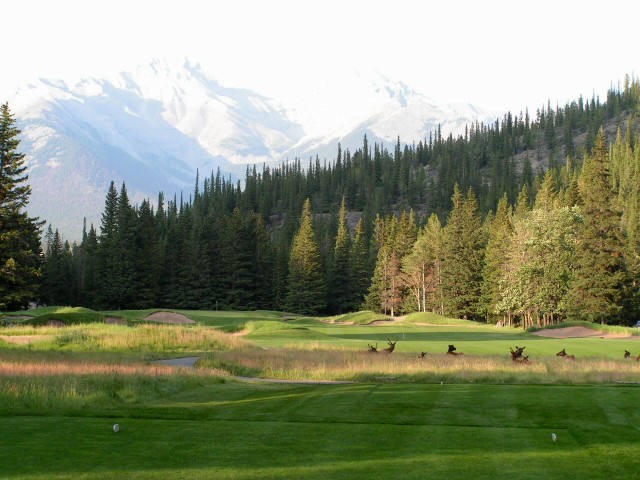
Ho-hum – just another day at Banff! As for the golf, the built up bunkering left pushes the golfer right, which is rarely ideal.
Eighteenth hole, 585 yards, Windy; The similarities with the Long hole on the Old Course at St. Andrews seem striking: the corner of the out of bounds right which must be challenged if one wants to get home in two and the massive central hazard ‘Hell’ bunker 120 yards from the greengive this hole much strategic interest. In three rounds here, the author witnessed everything from a couple of short eagle putts to a quadruple bogey. Such swings in fortune make this a most engaging Home hole.
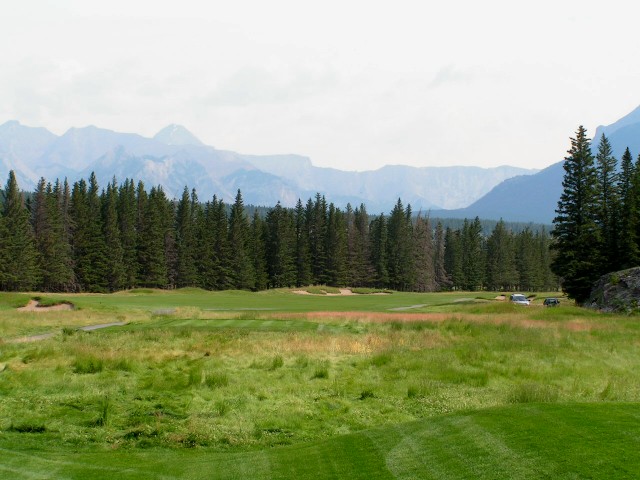
As seen from the tee on this dogleg right, the tiger golfer needs to flight his ball long down the right, flirting with the out of bounds road as marked by the two moving vehicles on the right.
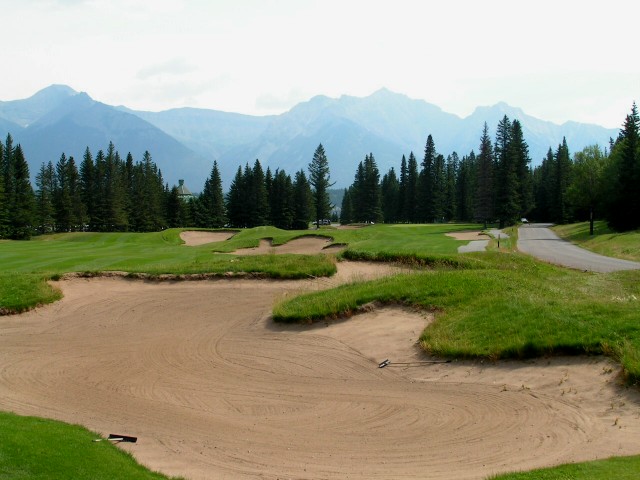
The bunker in the foreground ends 290 yards from the tee. Further ahead, a fifteen foot deep bunker sits in the middle of the fairway 120 yards from the green.
Much has been made about the change in the sequencing of the holes when the new clubhouse was added in 1989. When asked about it, Doug Wood said that all Banff can do now is ask the golfer to judge the course as one plays it today on its own merits. The old routing will never be brought back into official play.Many lament the loss of the thrilling first tee ball across the Spray River and of the climatic finishing five holes starting at what is today’s 10th. To finish near the base of the Banff Springs Hotel after having played such a terrific stretch of holes must have been as satisfying a conclusion as any course in the world. Plus, Thompson specifically designed the course to finish in such a stern manner, in keeping with such great courses as Merion Golf Club and Winged Foot West.
Conversely, the contrary an view is that with today’s sequence of holes, the out and back nature of the course is nicely broken up. Also, many golfers prefer to play the toughest stretch more in the middle of their round when they are warmed up and playing well ala such courses as National Golf Links of America and Fishers Island. Plus, today’s 16th-18th holes offer more birdie and even an eagle opportunity, so the golfer might end on more of a positive high. Also too, in Thompson’s day, the Banff Springs Hotel could be seen from 14 of the holes and its presence must have been especially felt playing those last five holes. However, with the growth in the evergreen trees over the past 3/4 of a century since the course opened, the Banff Springs Hotel is less dominate upon the landscape and thus there is less of a sense of returning toward it.
However, be all this as it may, the ultimate merit of the course must reside with a discussion of the merit of the holes themselves. Taken as a set, the one shotters (the second, fourth, eighth, 10th, and 13th) are truly of exception. How many courses can boast such variety? Not many, certainly less than ten. As for the three shotters (the third, seventh, ninth, and 18th), again the golfer concludes them to be of a very high standard.Only at the ninth can the golfer escape with a loose shoot or two but Thompson intended as much given the stretch that immediately follows.The other three are all very good. Finally, as one ticks through the remaining two shot holes (the first, fifth, sixth, 11th, 12th, 14th, 15th, 16th, and 17th), only one or two might not readily appeal. Some like the fifth, 12th and 14th are among the best a golfer can ever hope to find on a single course.
Add in the incomparable setting and it becomes no wonder that as many golfers seek return games here decade after decade as at Pebble Beach and The Old Course at St. Andrews.There is no higher praise, such is the compelling nature of the game at Banff.
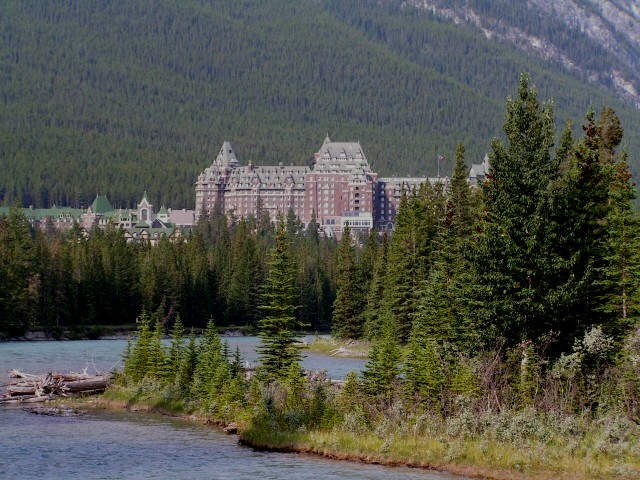
The best that nature and man have to offer can be found at Banff in Alberta, Canada.
The End



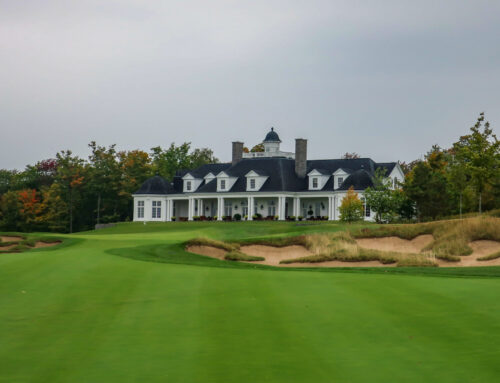
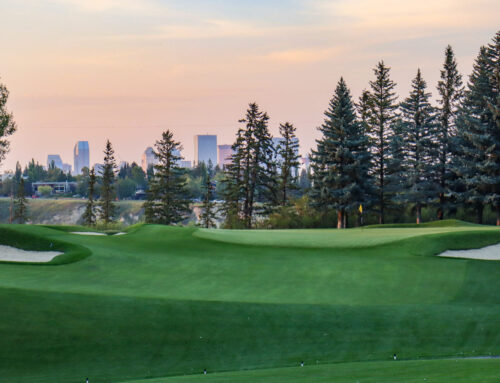
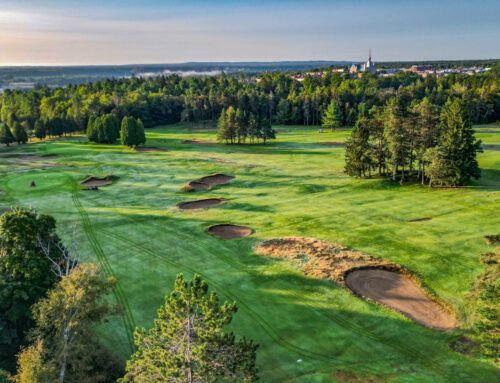

![Cabot Cape Breton (Links) [2013]](https://golfclubatlas.com/wp-content/uploads/2012/11/Cabot-Links-Golf-Course-500x383.jpg)
